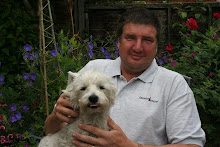 |
| A first look for Tigger, at the soggy, puddle-strewn front lawn |
 |
| Staying close to Mum |
I am not sure about Pedro anyway - I have seen him chasing the big ewe Myfanwy about and butting her a bit too aggressively for my liking so, even though he has not had a go at me, we may part company soon one way or another. At the moment I have him up for sale on the Irish 'classified ads' website (DoneDeal.ie) but I have not even had a 'tickle' so he may end up in the freezer. We'll see. If his chasing of 'Myf' is due to her not being pregnant yet and now coming on heat, then that might see him forgiven, but nobody needs a ram trying to 'T-bone' their in-lamb ewes in the midriff.
 |
| A house favourite use for a sheet of belly-pork. Mini porchetta. |
 |
| Thanks very much 'Steak-Lady' for this framed print, latest Paris-themed picture in our collection. |
 |
| Paris scene |
 |
| Pig haulier's breakfast. |
 |
| My new favourite Irish author, currently filling the gap left in my reading due to running out of Maeve Binchy books. |
Comparatively, the Irish funeral is massive, especially in rural areas where everybody would know the family of the deceased especially if they have lived in the community for all their life. Hundreds of people will attend and the proceedings can easily take up the evening prior and all of the day of the actual burial. Family and friends who have long since left Ireland in search of work or what-ever will make the trip home to be part of it. The deceased may even be one of the 'diaspora' wishing to be laid to rest in the family plot back in the village of their birth.
I apologise hugely in advance if I have any of this wrong - please do comment and I will make corrections. The last thing I want to do is cause any offence to anyone involved in 'this' or any other funeral. The proceedings follow a sequence something like this, with every bit attended by a good many of the mourners. First is the 'reposing' where the deceased is laid in the coffin at the Funeral Parlour - you queue outside for yards down the pavement to get in one door and you slowly process, shuffling forward to view the departed and then shake hands with the immediate family . It is good to have something to say to each - I have taken to using popular local expression "Sorry for your trouble". You then shuffle down the out-corridor to the exit, passing the book of condolences on the way. This stage takes a couple of hours to get everyone through. It is common for the coffin to be open at this stage, so that you see the deceased - I have not got used to that bit yet.
Next is the 'Removal', where the coffin is taken by hearse to the church, commonly followed by all those mourners in dozens of cars - an impressive cortege threading its way down the country lanes. The hearse may pause at the house where the deceased lived, or was born, letting the 'late' soul know that he is really home, I guess. This is followed by the Mass itself. Mass going is way more popular here than (taking Communion) in the UK and churches are packed every Sunday, so it is no surprise that all our mourners pack the church for this bit, likely to be the most familiar to mourners in the UK.
Next we move to the graveyard. Depending on distance this might be all back in the cars or walking. This is the 'Burial' and can involve, again, a big group of mourners gathered round while more prayers are said and the coffin lowered into the grave. Some of these graveyards can be on quite bleak, windy hilltops, so the wise mourner equips with a warm coat, hat and gloves. We then adjourn, if invited, to a suitable location for 'Refreshments' - in the case of my Father in Law (Theo), this was a nearby pub for drinks (obviously), welcome hot soup and bread, with sandwiches or even a full 3-course meal, maybe stew and veg and a dessert. This stage can go on as long as you want - there will often be live music and happy chatter as family members and friends who may not have seen each other since the last funeral catch up on gossip and each others lives.
You Brits can see that this all adds up to quite a day, an impressive event. More amazing (to us) is that this all happens generally within days of the passing away of the person, the whole 'machine' fires up and all the stages are organised and slotted into place. In the UK, that is normally the work of weeks - we hear that person X has died and maybe 3 weeks later we find out the arrangements for the funeral. They KNOW that this is all a bit special here and there have been some excellent (including funny in some cases) books written and TV programmes made explaining the process. I hesitate to compete with those, but thought my UK friends might like a small flavour of what it means when someone here says "There was a funeral".
Additional reading - Try the book "How to be Irish" by David Slattery
https://www.amazon.co.uk/How-Irish-Uncovering-Curiosities-Behaviour/dp/1871305241



No comments:
Post a Comment